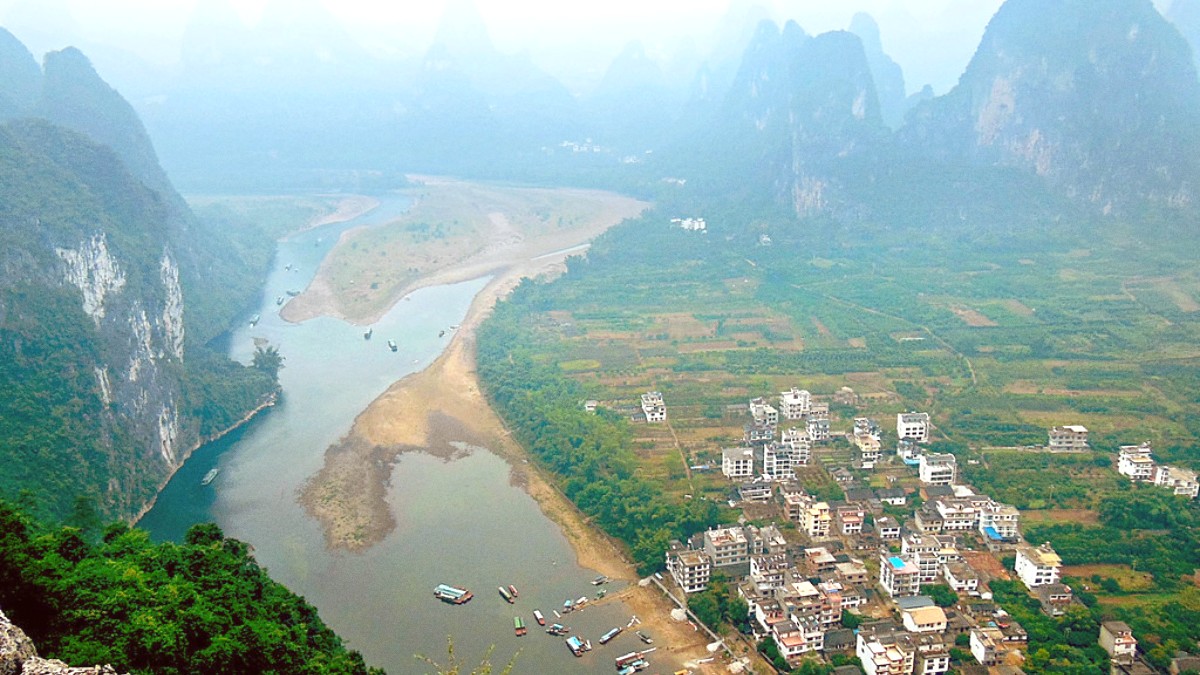
Guangxi, China
This guide assists your trip preparation, seeing you gain the most from this unique destination. It delivers practical advice, from travel planning to finding the best local foods and activities. Yangshuo is a place to connect with nature and local culture, creating memories that last a lifetime.
Imagine a landscape where towering green mountains rise from the earth like ancient giants, their forms reflected in clear, winding rivers below. Picture yourself drifting along a serene waterway on a bamboo raft, surrounded by this dramatic scenery, or cycling through emerald rice paddies with karst peaks rising on all sides.
This is Yangshuo, a place in China that feels pulled from a classical painting. It draws travelers with outdoor adventure, cultural experiences, and quiet moments in nature. Here, the everyday pace slows, letting you breathe in fresh air and immerse yourself in a world where natural beauty meets ancient traditions. This guide shows you how to explore its rivers, climb its peaks, and savor its unique flavors. It details planning, packing, and making genuine connections with this special corner of Guangxi.
Yangshuo County sits in the northeast of the Guangxi Zhuang Autonomous Region, China. It is approximately 65 kilometers (40 miles) southeast of Guilin city, a common entry point for travelers. The location along the Li River's banks puts it at the heart of China’s famous karst landscape. This unique topography consists of limestone peaks, often conical or pillar-shaped, shaped by millions of years of erosion. These formations create a dramatic backdrop that has inspired Chinese artists for centuries. The land features winding rivers and extensive cave systems, adding to its geological interest.
Yangshuo's history stretches back over 1,400 years, with its establishment as a county in 590 AD during the Sui Dynasty. For centuries, it remained a quiet fishing village and an agricultural hub, its existence shaped by the rhythm of the Li River and the fertile surrounding lands. Local farmers cultivated rice in the valleys, and fishermen relied on traditional methods, including cormorant fishing. While no longer a main economic activity, demonstrations of cormorant fishing remain a cherished cultural display.
Dramatic limestone peaks that define the region's scenery.
Iconic waterway for scenic boat cruises.
A quieter tributary, popular for bamboo raft trips and cycling.
Extensive limestone caves for underground exploration.
Emerald fields that contribute to the picturesque rural setting.
The late 20th century brought a shift. Word of Yangshuo’s exceptional natural beauty spread among international backpackers. Early visitors were drawn to the dramatic landscapes, the relaxed pace of life, and the inexpensive travel options. Their presence slowly transformed the quiet village into a recognized tourist destination. West Street, once a simple market lane, evolved into a bustling pedestrian street, catering to both local and foreign visitors.
Yangshuo today presents a fascinating blend of old and new. You see ancient traditions like cormorant fishing demonstrations next to modern cafes. The karst mountains, unchanged for millennia, overlook a town adapting to global tourism while striving to maintain its local character.
The history of Yangshuo is visible in its older buildings, the enduring agricultural practices in the surrounding countryside, and the continued flow of the Li River, which has sustained life here for centuries.
The landscape feels immersive, with karst formations visible from nearly every vantage point. This combination of mountains, rivers, and caves makes Yangshuo a destination for outdoor enthusiasts and those seeking picturesque natural beauty.
Yangshuo County covers an area of 1,428 square kilometers (551 sq mi). The 2020 Census reported a population of approximately 320,000 residents. While the population count includes the entire county, the town of Yangshuo itself feels smaller and more concentrated, especially around its tourist core.
Tourism powers the local economy. This focus means you find a well-developed infrastructure catering to visitors, including numerous hotels, restaurants, tour operators, and shops. The area’s unique geographical features attract travelers. These include the distinctive karst mountains, the meandering Li River, the tranquil Yulong River, and various cave systems. These natural elements are the main draw, shaping the region’s identity and its offerings.
Mandarin Chinese (Putonghua) is the main language. Local dialects like Guiliu Mandarin are also common.
China Standard Time (CST), which is UTC+8.
Chinese Yuan (CNY) / Renminbi (RMB). Mobile payment via WeChat Pay and Alipay is dominant.
Translation apps are also helpful.